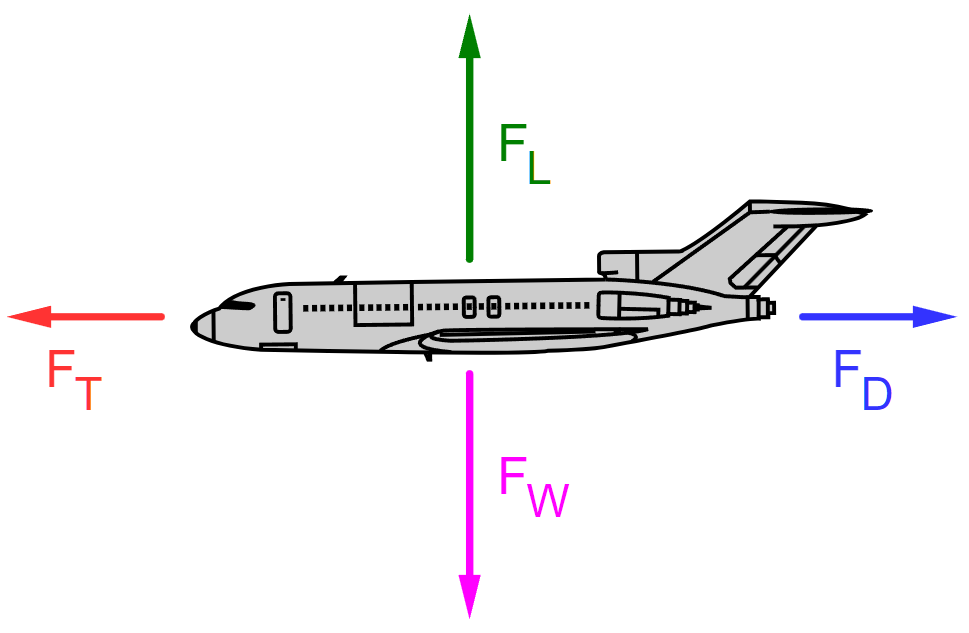In aeronautics, there are 4 main forces of flight. These are:
- Lift ()
- Weight ()
- Thrust ()
- Drag ()
 Image courtesy of Wikimedia Commons
Image courtesy of Wikimedia Commons
This model is simplified to movement in 2 dimensions. There are other combination of forces that allow us to turn. But let's keep the model simple for now.
The interaction of these four forces provide everything we need to move an aircraft.
Lift
Aerodynamic force generated by the airplane's shape. Most of the lift comes from the control surfaces and wings. As air passes through them, it is displaced and causes a reaction on the airplane. The shape of the wings help manipulate this force upwards. Some residual forces create drag, that will be reviewd later on.
Perpendicular to the direction of flight.
Weight
Always towards the center of the earth and is simply the mass of the airplane multiplied by the gravitational acceleration.
Thrust
Force created by the propulsion system usually along the direction of motion. This is not always the case. For example, for airplanes that need short takeoff or for vertical landings (like the F-35), the thrust is redirected elsewhere.
The stronger this force, then the aircraft can move faster, along it to get higher groundspeeds. Also, moving faster means that more air is affected by the body, which helps with generating lift. So higher thrust also helps with higher altitudes.
Note that the thrust has to overcome the force of drag, not lift on the airplane. An engine doesn't provide enough force to lift the entire aircraft. As long as it is enough to overcome drag and the shape of the airplane helps the lift component to overcome weight, the aircraft will take off. If the engine was able to completely lift the aircraft without the lift, then there will be no need for wings. Just point the engine down! Although now you have to add other engines to move the airplane sideways...
Drag
aerodynamic force
As the airplane passes through the sky, the molecules of air already there are forced to move to make room for the aircraft. This displacement is used as lift but some creates drag that slows down the plane. This force is squarely proportional to the speed of the airplane, so if the airplane doubles its speed, this force increases by 4.
It is always along and opposed to the flight direction.
Force Pairs
These four forces work to push and pull the aircraft and are coupled. Thrust and drag are opposite forces just like lift and weight. An increase in one of these forces causes the aircraft to become unbalanced and accelerate. This is not a bad thing! We want the aircraft to accelerate upwards (pointing towards the lift component) to climb and to accelerate forwards (towards the thrust component) to gain speed.
Forces are balanced
This happens in cruise flight when the aircraft is not accelerating. In this instance, the thrust is equal to drag, providing no acceleration horizontally. Similarly, the lift is equal to the weight in the vertical direction, so the airplane is not climbing or descending.
Thrust is higher than drag
So if thrust is greater than drag, the sum of these two forces results in a positive force towards the front of the airplane, meaning that the aircraft will accelerate.
You can also consider than an excess thrust can be used to make the aircraft climb. How? By changing the angle of attack of the airplane! Then some of the thrust will be converted to lift.
Lift is higher than weight
What happens if the force pointed upwards is higher than the force going down? The aircraft will climb!
